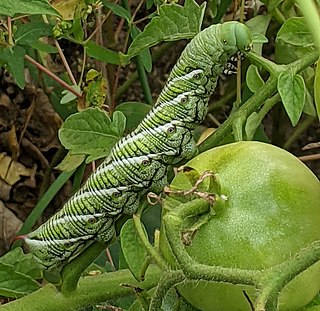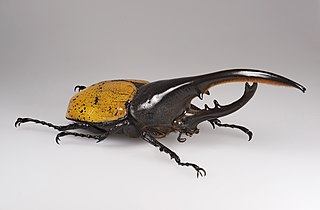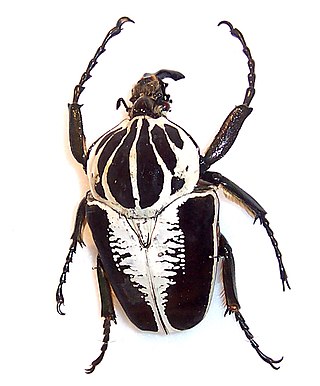
Mealworms are the larval form of the yellow mealworm beetle, Tenebrio molitor, a species of darkling beetle.

Manduca sexta is a moth of the family Sphingidae present through much of the Americas. The species was first described by Carl Linnaeus in his 1763 Centuria Insectorum.

Histeridae is a family of beetles commonly known as clown beetles or hister beetles. This very diverse group of beetles contains 3,900 species found worldwide. They can be easily identified by their shortened elytra that leaves two of the seven tergites exposed, and their geniculate (elbowed) antennae with clubbed ends. These predatory feeders are most active at night and will fake death if they feel threatened. This family of beetles will occupy almost any kind of niche throughout the world. Hister beetles have proved useful during forensic investigations to help in time of death estimation. Also, certain species are used in the control of livestock pests that infest dung and to control houseflies. Because they are predacious and will even eat other hister beetles, they must be isolated when collected.

Dermestidae are a family of Coleoptera that are commonly referred to as skin beetles. Other common names include larder beetle, hide or leather beetles, carpet beetles, and khapra beetles. There are over 1,800 species described.

The huhu beetle is a longhorn beetle endemic to New Zealand. It is the heaviest beetle found in New Zealand.
Holometabolism, also called complete metamorphosis, is a form of insect development which includes four life stages: egg, larva, pupa, and imago. Holometabolism is a synapomorphic trait of all insects in the superorder Holometabola. Immature stages of holometabolous insects are very different from the mature stage. In some species the holometabolous life cycle prevents larvae from competing with adults because they inhabit different ecological niches. The morphology and behavior of each stage are adapted for different activities. For example, larval traits maximize feeding, growth, and development, while adult traits enable dispersal, mating, and egg laying. Some species of holometabolous insects protect and feed their offspring. Other insect developmental strategies include ametabolism and hemimetabolism.

The Hercules beetle is a species of rhinoceros beetle native to the rainforests of southern Mexico, Central America, South America, and the Lesser Antilles. It is the longest extant species of beetle in the world, and is also one of the largest flying insects in the world.

Dynastes tityus, the eastern Hercules beetle, is a species of rhinoceros beetle native to the Eastern United States. The adult's elytra are green, gray or tan, with black markings, and the whole animal, including the male's horns, may reach 60 mm (2.4 in) in length. The larvae feed on decaying wood from various trees.

Odontotaenius disjunctus, the patent-leather beetle or horned passalus, is a saproxylic beetle in the family Passalidae which can grow to just over an inch-and-a-half long, weigh 1-2 grams and are capable of pulling 50 times their own weight. They have been used to study several aspects of general family characteristics since the early 1900s but remain a relatively unknown species within the diverse Coleoptera order.

The Japanese rhinoceros beetle, also known as the Japanese rhino beetle, the Japanese horned beetle, or by its Japanese name kabutomushi, is a species of rhinoceros beetle. They are commonly found in continental Asia in countries such as China, the Korean peninsula, Japan, and Taiwan. In these areas, this species of beetle is often found in broad-leaved forests with tropical or sub-tropical climates. This beetle is well known for the prominent cephalic horn found on males. Male Japanese rhinoceros beetles will use this horn to fight other males for territory and access to female mating partners. Upon contact, males will attempt to flip each other onto their backs or off of their feeding tree. In response to selective pressures, smaller male A. dichotoma have adapted a "sneak-like behavior". These smaller beetles will attempt to avoid physical confrontation with larger males and try to mate with females.

The Goliath beetles are any of the six species in the genus Goliathus. Goliath beetles are among the largest insects on Earth, if measured in terms of size, bulk and weight. They are members of subfamily Cetoniinae, within the family Scarabaeidae. Goliath beetles can be found in many of Africa's tropical forests, where they feed primarily on tree sap and fruit. Little appears to be known of the larval cycle in the wild, but in captivity, Goliathus beetles have been successfully reared from egg to adult using protein-rich foods such as commercial cat and dog food. Goliath beetles measure from 60–110 millimetres (2.4–4.3 in) for males and 50–80 millimetres (2.0–3.1 in) for females, as adults, and can reach weights of up to 80–100 grams (2.8–3.5 oz) in the larval stage, though the adults are only about half this weight. The females range from a dark chestnut brown to silky white, but the males are normally brown/white/black or black/white.

The elephant beetle is a member of the family Scarabaeidae and the subfamily Dynastinae. Elephant beetles are Neotropical rhinoceros beetles.

Cotinis nitida, commonly known as the green June beetle, June bug or June beetle, is a beetle of the family Scarabaeidae. It is found in the eastern United States and Canada, where it is most abundant in the South. It is sometimes confused with the related southwestern species figeater beetle Cotinis mutabilis, which is less destructive.

Lucanus cervus, known as the European stag beetle, or the greater stag beetle, is one of the best-known species of stag beetle in Western Europe, and is the eponymous example of the genus. L. cervus is listed as Near Threatened by the IUCN Red List.

Lasioderma serricorne, more commonly referred to as the cigarette beetle, cigar beetle, or tobacco beetle, is a small beetle that shares a remarkable resemblance with the drugstore beetle and the common furniture beetle. The cigarette beetle, along with the drugstore and furniture beetles, all belong to the Ptinidae beetle family. The cigarette beetle can be distinguished from A. punctatum by its flatter thorax, whereas the A. punctatum boasts a humped thorax. The cigarette beetle can be further differentiated from S. paniceum with its uniformly serrated antennae composed of 11 segments, unlike the three-segmented antennae of S. paniceum. Additionally, L. serricorne has more shallow grooves in its elytra, or hardened wing covers, compared to the A. punctatum and S. paniceum’s deep grooving.

Galleria mellonella, the greater wax moth or honeycomb moth, is a moth of the family Pyralidae. G. mellonella is found throughout the world. It is one of two species of wax moths, with the other being the lesser wax moth. G. mellonella eggs are laid in the spring, and they have four life stages. Males are able to generate ultrasonic sound pulses, which, along with pheromones, are used in mating. The larvae of G. mellonella are also often used as a model organism in research.

Coccinellidae is a widespread family of small beetles. They are commonly known as ladybugs in North America and ladybirds in the United Kingdom; "lady" refers to mother Mary. Entomologists use the names ladybird beetles or lady beetles to avoid confusion with true bugs. The more than 6,000 described species have a global distribution and are found in a variety of habitats. They are oval beetles with a domed back and flat underside. Many of the species have conspicuous aposematic (warning) colours and patterns, such as red with black spots, that warn potential predators that they taste bad.

Lebia grandis is a ground beetle in the family Carabidae found in North America. It is a specialist predator on the eggs and larvae of Colorado potato beetles, and its larvae are obligate parasitoids of Colorado potato beetle pupae.

Hylobius transversovittatus is a species of weevil in the family Curculionidae. It is native to the Old World where both adults and larvae feed on purple loosestrife. This plant is regarded as an invasive species in North America and the weevil has been introduced into both the United States and Canada in an effort to control the plant.

Alphitobius diaperinus is a species of beetle in the family Tenebrionidae, the darkling beetles. It is known commonly as the lesser mealworm and the litter beetle. It has a cosmopolitan distribution, occurring nearly worldwide. It is known widely as a pest insect of stored food grain products such as flour, and of poultry-rearing facilities and it is a vector of many kinds of animal pathogens. In larval form, it is an approved novel food in the European Union, and also used as animal feed.





















